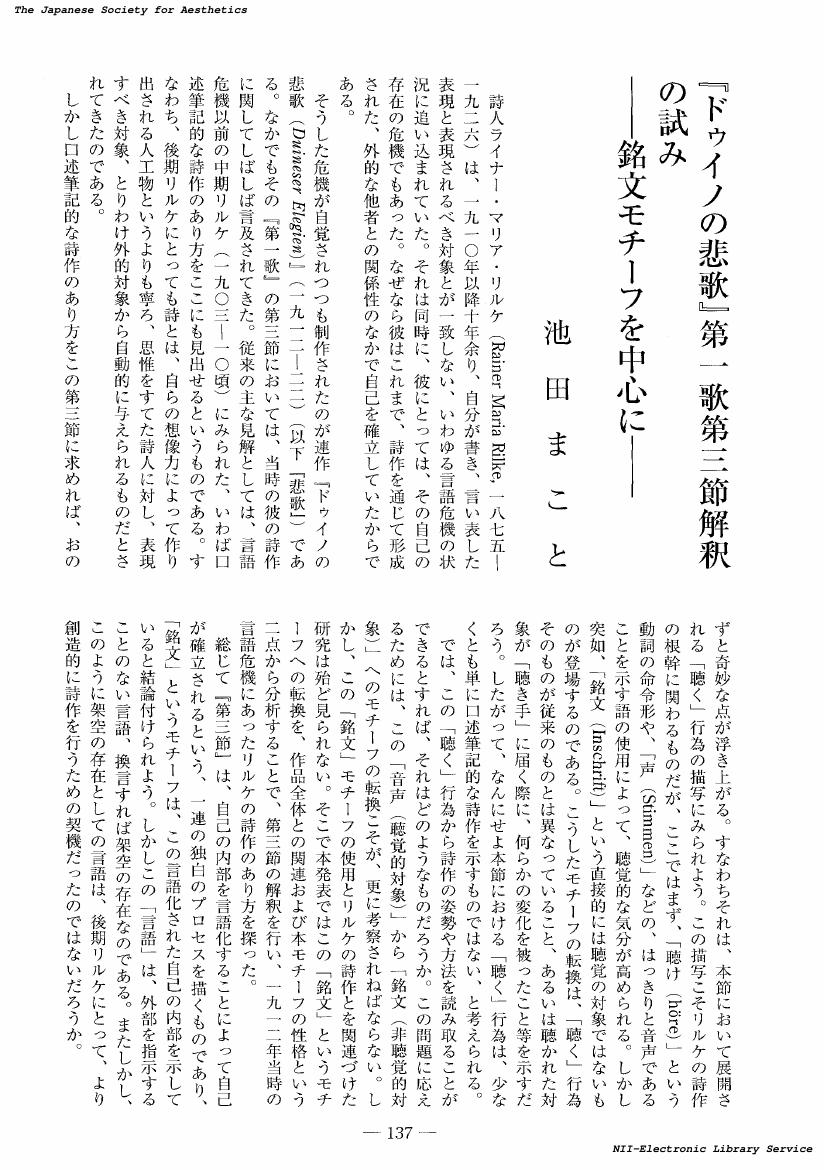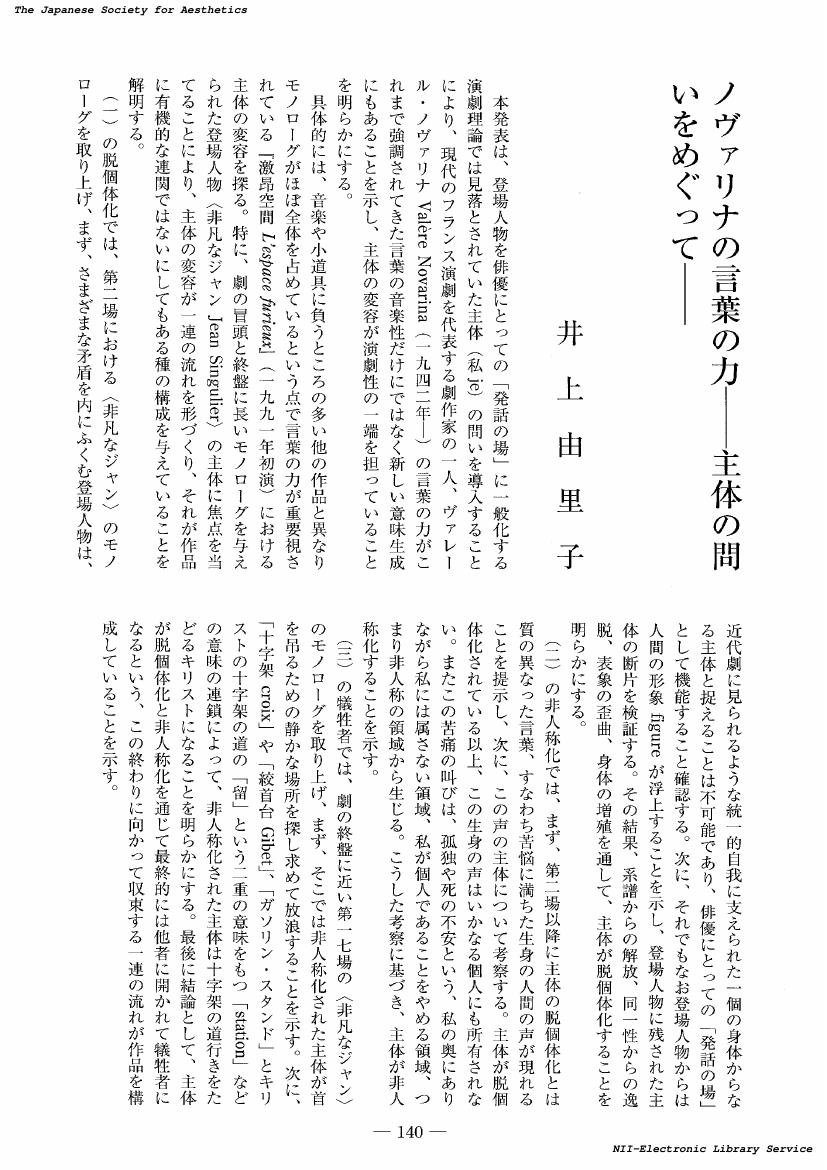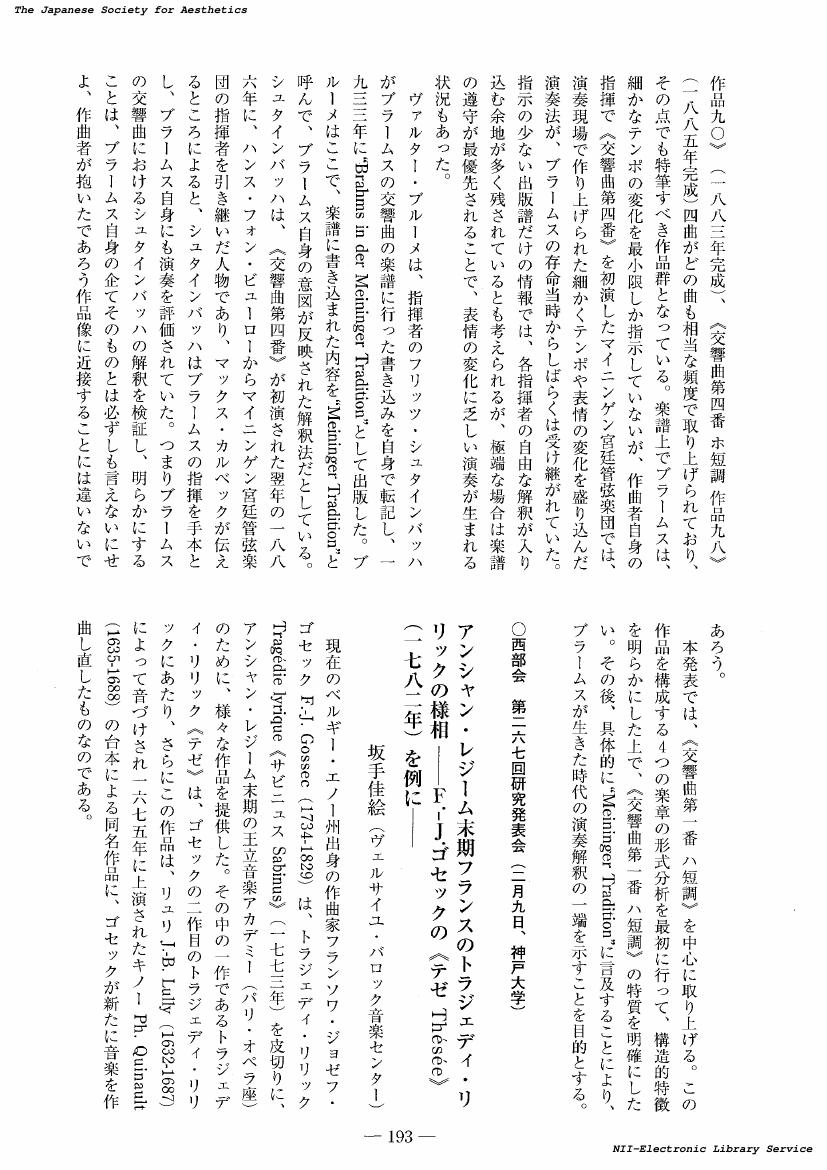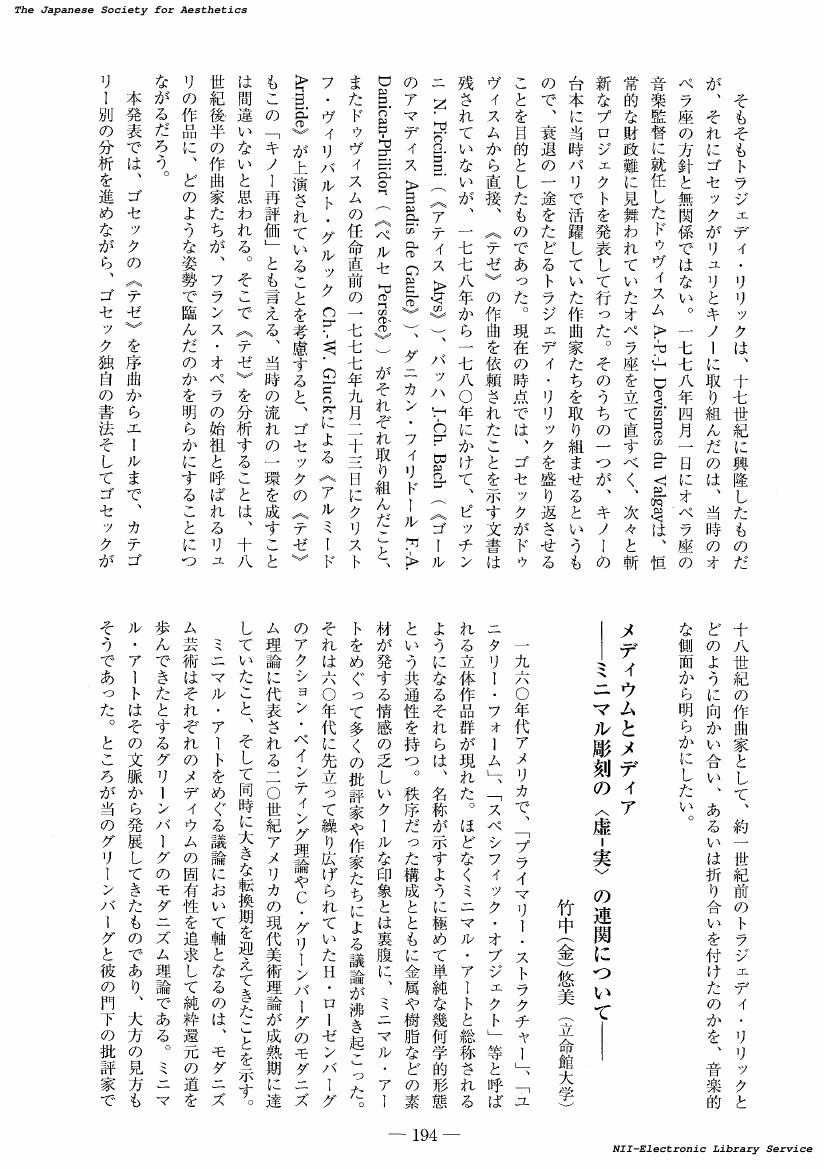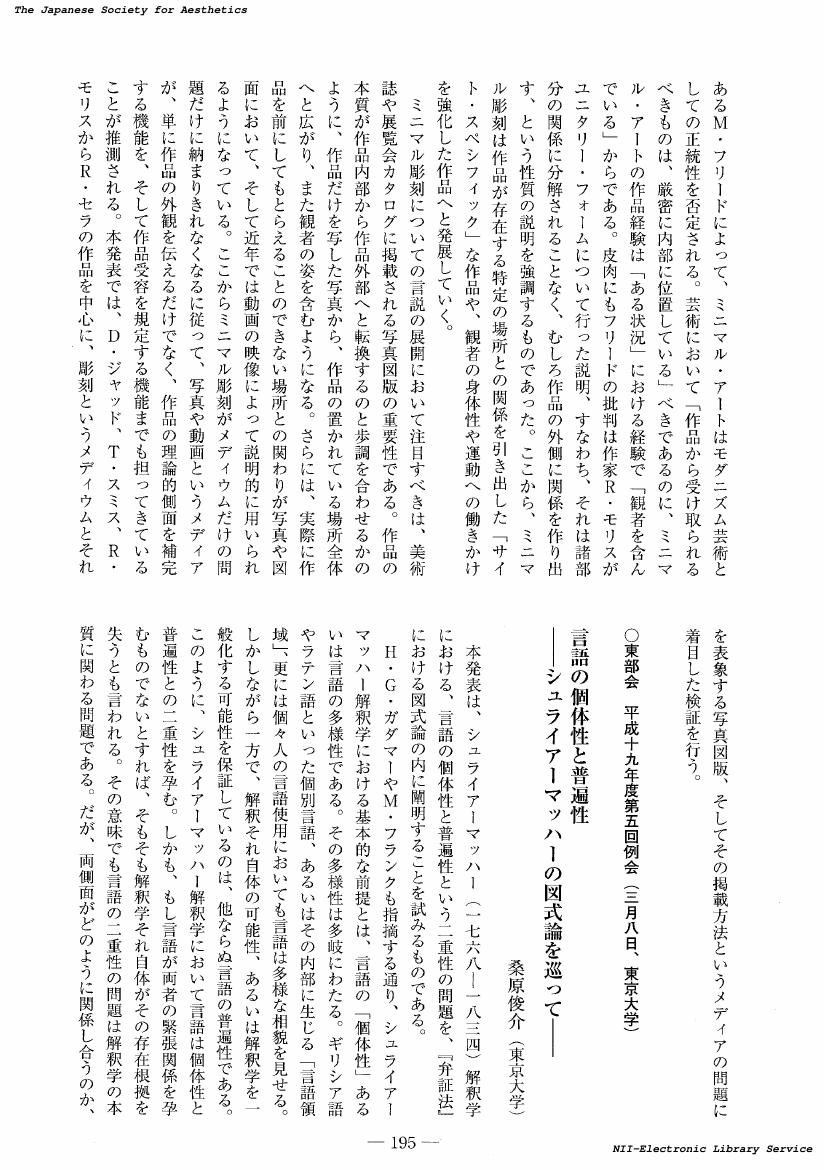1 0 0 0 OA 土田麥僊「平牀」と「妓生の家」について : 近代日本美術における朝鮮の美をめぐって
- 著者
- 上田 文
- 出版者
- 美学会
- 雑誌
- 美学 (ISSN:05200962)
- 巻号頁・発行日
- vol.59, no.2, pp.100-113, 2008-12-31 (Released:2017-05-22)
TSUCHIDA Bakusen (土田麥僊 1887-1936) was a modern Japanese painter in Kyoto. The purpose of this thesis is to consider his two works in his later years, Flat Bed (「平牀」) and House of Courtesan (「妓生の家」). Flat Bed is recently discussed in colonial studies and gender theories. Bakusen is an artist who treats the model as an object and therefore the kisaeng in his works is not treated as sexual object. The kisaeng's white folk dress line suggests "relief' in this work, which expresses the painter's artistic sense. House of Courtesan was sketched during his second visit to Korea and he could not finish this work because of his death. Here he depicted an old man, an old woman and a kisaeng; the theme differed from his former works. Therefore, I think this change was due to his visits to Korea where he was influenced by Portrait of Li Qixian, a famous scholar in Koryo Dynasty, and Portrait of Gonso Sojo, a Japanese religious picture. In his new portrait painting he tries to unite a portrait and a religious picture. By comparing his two works in this thesis, it can be stated that Bakusen is a modern Japanese painter who developed a new style of arts from the inspiration of Korean works.
- 著者
- 河合 大介
- 出版者
- 美学会
- 雑誌
- 美学 (ISSN:05200962)
- 巻号頁・発行日
- vol.59, no.2, pp.128-130, 2008-12-31 (Released:2017-05-22)
- 著者
- 池田 まこと
- 出版者
- 美学会
- 雑誌
- 美学 (ISSN:05200962)
- 巻号頁・発行日
- vol.59, no.2, pp.137, 2008-12-31 (Released:2017-05-22)
- 著者
- 石谷 治寛
- 出版者
- 美学会
- 雑誌
- 美学 (ISSN:05200962)
- 巻号頁・発行日
- vol.59, no.2, pp.138, 2008-12-31 (Released:2017-05-22)
1 0 0 0 OA B・ゴート:「芸術クラスター説」の検討と応用(第五十九回美学会全国大会発表要旨)
- 著者
- 伊藤 佐紀
- 出版者
- 美学会
- 雑誌
- 美学 (ISSN:05200962)
- 巻号頁・発行日
- vol.59, no.2, pp.139, 2008-12-31 (Released:2017-05-22)
1 0 0 0 OA ノヴァリナの言葉の力 : 主体の問いをめぐって(第五十九回美学会全国大会発表要旨)
- 著者
- 井上 由里子
- 出版者
- 美学会
- 雑誌
- 美学 (ISSN:05200962)
- 巻号頁・発行日
- vol.59, no.2, pp.140, 2008-12-31 (Released:2017-05-22)
- 著者
- 平山 敬二
- 出版者
- 美学会
- 雑誌
- 美学 (ISSN:05200962)
- 巻号頁・発行日
- vol.59, no.1, pp.196-197, 2008-06-30 (Released:2017-05-22)
1 0 0 0 OA T・E・ヒュームの芸術論と原(プロト)ファシズム・イデオロギー
- 著者
- 石田 圭子
- 出版者
- 美学会
- 雑誌
- 美学 (ISSN:05200962)
- 巻号頁・発行日
- vol.59, no.2, pp.2-15, 2008-12-31 (Released:2017-05-22)
T. E. Hulme, an aesthetician and a critic, is famous for his contribution to Imagism, one of the most important movements of Anglo-American Modernism. This leading figure of Modernism is also notorious as a sympathizer of protofascism who celebrates Charles Maurras and Georges Sorel. In this paper, I try to analyze the relation between Hulme's aesthetics and the ideology of protofascism. In his essays, rejecting the sensibility of Romanticism, Hulme insists on the superiority of Classicism, which is, actually, deeply affected by the political and literary view of Maurras who regards Classicism as 'anti' to liberalism and democracy. Moreover his keen interest in geometric-abstract art reflects his worldview - reactionary modernism whose core is 'the religious attitude'. In this view, he supports Sorel's political theory in which he finds Classicism and the religious attitude. Finally I point out the homogeneity between Hulme's idea and protofascistic Weltanschauung by taking an overview on the rise of irrationalism and the vulgarized Lebensphilosophie. This close relationship between aesthetics and protofascism in Hulme's thought suggests that Modernism and fascism, the two concepts that are widely assumed to be antithetical, might partly have an profound kinship.
1 0 0 0 OA フーコーにおける「感性論」の可能性 : 「外」との関わりから
- 著者
- 武田 宙也
- 出版者
- 美学会
- 雑誌
- 美学 (ISSN:05200962)
- 巻号頁・発行日
- vol.59, no.2, pp.30-43, 2008-12-31 (Released:2017-05-22)
Cet article se propose d'expliciter le rapport de Michel Foucault a l'esthetique a partir d'un concept du dehors. Qu'est-ce que Foucault entend exactement par <<dehors>>? En reconstituant le jeu que joue ce concept ou en suivant les variations de ce <<dehors>> dans la pensee de ce philosophe, je voudrais formuler une hypothese: que ce concept, qu'il arrache aux textes de Maurice Blanchot dans La pensee du dehors se situe au centre de l'esthetique de Foucault. Une de ces variations, c'est <<l'enonce>> qu'il a propose dans L'archeologie du savoir. C'est une unite dans le discours a laquelle il a donne une certaine qualite de<<materialite incorporelle>>, qui est derivee du stoisisme ou la subjectivite est structuree selon un mode different de celui de la conscience. On peut entendre ici la resonance de <<l'autre dans le Meme>>, ce que Emmanuel Levinas a evoque dans son oeuvre. On voit egalement le dernier theme que Foucault s'est efforce a rechercher: la vie comme oeuvre d'art. Il a pense qu'il y a un moment d'une prise de relations avec l'exteriorite dans l'interiorite. Cette recherche conduit finalement a un chiasme de l'esthetique et de l'ethique. Il me semble que son attention sur l'ethique indique l'indifferenciation originaire des deux, que l'esthetique moderne a elimine.
1 0 0 0 OA 融解する表面 : ヘレニズム以前のギリシアにおけるプロソポンの考察
- 著者
- 佐藤 真理恵
- 出版者
- 美学会
- 雑誌
- 美学 (ISSN:05200962)
- 巻号頁・発行日
- vol.59, no.2, pp.44-57, 2008-12-31 (Released:2017-05-22)
A classical Greek noun, prosopon originally means both face and mask. This paper takes advantage of the reason why this term connotes both of them, which seem directly-opposed ideas by our means. Prosopon is consisted of prefix pros and noun ops, and signifies the thing towards etes literally. It is, to sum up, appearance as surface-front, and dislocates structure of binomial confrontation between face and mask. Nevertheless, it is also impossible to disregard the rest of prosopon which is beyond description in just an aspect above-mentioned of it. Because, prosopon which need the others and is given by the exterior, is fated to be read by someone confront, for indeed its character it is open for and exists in the exterior. And, from a point of view of the watching it, these surface prosopon is a field presence and absence crossing. However, in the other side, in the ancient Greek texts, the action that restores its primary mean as appearance has applied to a moment for conquer a fear of death. Anyway, different from a modern concept, prosopon in the ancient Greek is heteronomous, the face that could not but start from the character of surface-front.
- 著者
- 佐々木 千佳
- 出版者
- 美学会
- 雑誌
- 美学 (ISSN:05200962)
- 巻号頁・発行日
- vol.59, no.2, pp.58-71, 2008-12-31 (Released:2017-05-22)
Un noto ritratto virile, oggi conservato alla Biblioteca Trivulziana di Milano su un foglio miniato, ci presenta un' immagine molto originate e simbolica. L'attenzione degli studiosi e stata lungamente ed esclusivamente attratta da problemi stilistici e di attribuzione, nonche dalla questione dell'identita del soggetto rappresentato, ma senza una adeguata considerazione della funzione dell'opera come ritratto dell'autore del testo della pergamena a cui l'immagine e ancorata come un dono. La Fletcher (1991) ha riconosciuto nel ritratto un'opera di Giovanni Bellini, finora ritenuta perduta, appartenente in origine al manoscritto del Istrias di Raffaele Zovenzoni. Sulla base di questa ipotesi da noi condivisa, ci sembra opportuno collocare l'opera sullo sfondo di una specifica e importantissima attivita tecnico-artigianale dell'epoca, quella della produzione e decorazione libraria. Si puo riconoscere nel ritratto l'effigie dell' autore del testo delle odi dell' Istrias, a cui si accompagna in un rapporto intertestuale di simbolicita-individualita determinato dalla finalita della sua destinazione. Il pittore idealizza l'immagine del poeta usando motivi architettonici e attributi tipici della tradizione della decorazione libraria, evocando una presence reelle dello sguardo dell'autore delle odi direttamente rivolto al dedicatario come un sostituto reale del donatore. Proprio questa, a nostro avviso, e la funzione originaria e it significato dell'immagine nel contesto funzionale e nella sua posizione cronologica nella seconda meta del Quattrocento.
1 0 0 0 OA 聖アウグスティヌスの書斎 : カルパッチョ作「スラブ人会」連作をめぐって
- 著者
- 森田 優子
- 出版者
- 美学会
- 雑誌
- 美学 (ISSN:05200962)
- 巻号頁・発行日
- vol.59, no.2, pp.72-85, 2008-12-31 (Released:2017-05-22)
The cycle of Sts. George, Jerome and Tryphon for the Scuola Dalmata was executed by Vittore Carpaccio in ca. 1502-1511. The Vision of St. Augustine of the cycle is based on the apocryphal letters. Compared with the examples of same subject and the representations of the other study, it reveals that this work is different from the traditional iconography. The setting of study and chapel focused on both the contemplative life and the daily work of bishop. It finds also the details which demonstrate a kind of collectionism. These become the factors which remind anyone's portrait. When we concern on this problem, it's important to see it in the patronal context. The production of the cycle has been inspired by the donation of the relic by Paolo Vallaresso, and it's also important to remember that Maffeo Vallaresso is the archbishop of Zara. He is the humanist-ecclesiastic, interested with the art, which recorded in his letters. On considering these factors, the setting of study and art-conscious details, in the contemporary context, so it can say that the St. Augustine's study is intended to allude the intellectual and ecclesiastical figure of Maffeo Vallaresso.
- 著者
- 森田 優子
- 出版者
- 美学会
- 雑誌
- 美学 (ISSN:05200962)
- 巻号頁・発行日
- vol.59, no.1, pp.188, 2008-06-30 (Released:2017-05-22)
- 著者
- 芳賀 京子
- 出版者
- 美学会
- 雑誌
- 美学 (ISSN:05200962)
- 巻号頁・発行日
- vol.59, no.1, pp.189-190, 2008-06-30 (Released:2017-05-22)
- 著者
- 渡辺 裕
- 出版者
- 美学会
- 雑誌
- 美学 (ISSN:05200962)
- 巻号頁・発行日
- vol.59, no.1, pp.190-191, 2008-06-30 (Released:2017-05-22)
- 著者
- 佐藤 真理恵
- 出版者
- 美学会
- 雑誌
- 美学 (ISSN:05200962)
- 巻号頁・発行日
- vol.59, no.1, pp.191-192, 2008-06-30 (Released:2017-05-22)
- 著者
- 小味渕 彦之
- 出版者
- 美学会
- 雑誌
- 美学 (ISSN:05200962)
- 巻号頁・発行日
- vol.59, no.1, pp.192-193, 2008-06-30 (Released:2017-05-22)
1 0 0 0 OA アンシャン・レジーム末期フランスのトラジェディ・リリックの様相 : F.-J.ゴセックの《テゼThesee》(一七八二年)を例に(西部会第二六七回研究発表会,例会・研究発表会要旨)
- 著者
- 坂手 佳絵
- 出版者
- 美学会
- 雑誌
- 美学 (ISSN:05200962)
- 巻号頁・発行日
- vol.59, no.1, pp.193-194, 2008-06-30 (Released:2017-05-22)
- 著者
- 竹中(金) 悠美
- 出版者
- 美学会
- 雑誌
- 美学 (ISSN:05200962)
- 巻号頁・発行日
- vol.59, no.1, pp.194-195, 2008-06-30 (Released:2017-05-22)
- 著者
- 桑原 俊介
- 出版者
- 美学会
- 雑誌
- 美学 (ISSN:05200962)
- 巻号頁・発行日
- vol.59, no.1, pp.195-196, 2008-06-30 (Released:2017-05-22)

